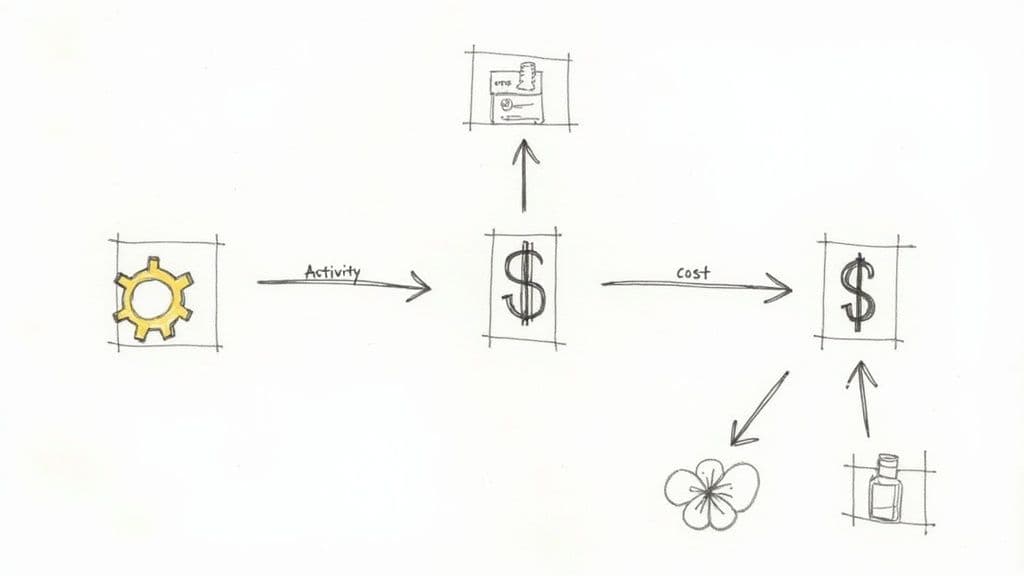In today's competitive landscape, unchecked overheads can quietly erode your profitability. Many businesses struggle with rising costs, from office space and utilities to administrative bloat and inefficient processes. The key isn't just cutting corners; it's about making strategic, intelligent changes that foster efficiency and sustainable growth. This guide moves beyond generic advice to provide a detailed roadmap of seven powerful, proven strategies that businesses are using to significantly reduce overhead costs.
We will explore everything from advanced costing methods and lean principles to leveraging technology and optimising supplier relationships. Each strategy is packed with actionable steps, real-world examples, and practical tips designed for immediate implementation. Think of this as your blueprint for transforming your operations into a leaner, more agile model. For a comprehensive overview, explore additional proven cost reduction strategies that businesses can implement to achieve an even leaner operation.
By implementing these insights, you can do more than just slash expenses. You will be able to strengthen your bottom line, build a more resilient, profitable organisation for the future, and gain a critical competitive edge. Let's dive into the methods that will make a real difference.
1. Implement Activity-Based Costing (ABC)
Traditional accounting often allocates overheads using a broad-brush approach, such as applying a single percentage based on direct labour hours. This can distort the true cost of your products or services. Activity-Based Costing (ABC) offers a more precise method to reduce overhead costs by linking them directly to the activities that drive them. Popularised by Harvard Business School professors Robert Kaplan and Robin Cooper, ABC identifies every activity required to deliver a product or service and assigns costs based on actual resource consumption.
This granular view allows you to see exactly where your money is going. For example, you might discover that one particular service requires a disproportionate amount of customer support time, making its profit margin much lower than you initially realised. By understanding these cost drivers, you can make informed decisions to streamline inefficient processes, re-price services, or eliminate non-essential activities altogether.

7caab4a0-1672-45c5-a477-090cffe07502.jpg
How to Implement Activity-Based Costing
Implementing ABC requires a systematic approach to accurately map your costs.
- Identify Cost-Driving Activities: Begin by listing all the indirect activities involved in your business operations. This could include tasks like client onboarding, content creation, software maintenance, or handling customer enquiries.
- Assign Costs to Activities: Allocate your overheads (rent, utilities, salaries for administrative staff) to these specific activity pools. For example, a portion of your office rent is allocated to the "customer support" activity.
- Determine Cost Drivers: For each activity, identify a "cost driver," which is the unit of measure for consumption. For customer support, the driver might be the number of support tickets; for content creation, it could be the number of hours spent.
- Calculate the Rate: Divide the total cost of each activity pool by its total cost drivers to get a cost driver rate.
- Allocate Costs: Finally, assign overhead costs to your products or services based on how many units of the cost driver they consume.
Key Insight: ABC transforms overheads from a nebulous, uncontrollable expense into a series of manageable activities. This shift in perspective is crucial for any business serious about optimising its cost structure and making strategic decisions to reduce overhead costs effectively. Giants like Hewlett-Packard and Boeing have used ABC to save millions and enhance operational efficiency.
2. Lean Management and Waste Elimination
While many businesses focus on broad cost-cutting measures, the lean methodology offers a more strategic path to reduce overhead costs by systematically eliminating waste. Originating from the Toyota Production System pioneered by figures like Taiichi Ohno, lean management is a philosophy focused on maximising customer value while minimising resource use. It identifies seven key types of waste, or "muda," in any process: transport, inventory, motion, waiting, overproduction, over-processing, and defects.
By applying lean principles, you can streamline everything from administrative workflows to IT operations, not just manufacturing. For instance, you might discover that your client onboarding process involves excessive waiting periods or unnecessary data re-entry, both of which inflate administrative overhead. Eliminating these non-value-adding steps directly reduces labour costs and frees up team capacity for more productive tasks, making it a powerful way to enhance efficiency.

ac3347ee-22ba-45af-bea7-1014bbdc0f88.jpg
How to Implement Lean Management
Adopting a lean mindset requires a commitment to continuous improvement and a structured approach to identifying and eradicating waste.
- Start with Value Stream Mapping: Begin by creating a visual map of your current process, from start to finish. This helps you identify every step, including bottlenecks, delays, and redundant tasks that add no value from the customer's perspective.
- Implement the 5S Methodology: Organise your physical and digital workspaces using the 5S principles: Sort, Set in Order, Shine, Standardise, and Sustain. A well-organised environment reduces time wasted searching for information or tools.
- Train Employees on Lean Principles: Equip your team with the knowledge and tools needed to spot waste in their daily work. Empowering them to suggest improvements creates a culture of continuous optimisation.
- Measure and Track Key Performance Indicators (KPIs): Regularly monitor metrics related to process cycle time, error rates, and resource utilisation. This data will validate your improvements and highlight new areas for focus.
Key Insight: Lean management shifts the focus from arbitrary budget cuts to intelligent process optimisation. By treating waste as a primary target, you can reduce overhead costs sustainably while simultaneously improving quality and customer satisfaction. Giants like Toyota, Nike, and even healthcare providers like Virginia Mason Medical Center have used these principles to drive significant financial and operational gains.
3. Technology Automation and Digital Transformation
In today's competitive landscape, manual, repetitive tasks are a significant drain on resources, consuming valuable employee time and introducing the risk of human error. Embracing technology automation and digital transformation is a powerful strategy to reduce overhead costs by streamlining workflows and optimising resource allocation. Championed by tech leaders like Satya Nadella and Marc Benioff, this approach involves using software, AI, and cloud-based systems to handle tasks that were once performed by people.
This strategic shift allows businesses to reallocate their human talent to higher-value activities like strategy, innovation, and customer relationships. For instance, instead of manually processing invoices or responding to basic customer queries, automation tools can execute these rule-based tasks flawlessly 24/7. To significantly cut down on operational overheads and boost overall efficiency, many businesses are now exploring strategies for automating business processes. This frees up capital and personnel, directly contributing to a leaner, more agile operation. Learn more about how you can leverage business process automation to enhance your operations.

c3bb1af8-0736-474c-8431-de5a91c8b14f.jpg
How to Implement Technology Automation
Successfully integrating automation requires a clear plan and a focus on generating tangible returns.
- Start with High-Impact Processes: Identify high-volume, rule-based tasks that are time-consuming but essential. Areas like data entry, customer onboarding, report generation, and social media scheduling are excellent starting points.
- Conduct a Thorough ROI Analysis: Before investing in a new tool, calculate the potential return on investment. Consider the cost of the software, implementation time, and training against the projected savings in labour hours and increased accuracy.
- Invest in Training and Change Management: Technology is only effective if your team uses it correctly. Provide comprehensive training and communicate the benefits clearly to ensure smooth adoption and minimise resistance to change.
- Choose Scalable Solutions: Select tools and platforms that can grow with your business. A scalable solution avoids the future cost and disruption of having to replace a system that you have outgrown.
Key Insight: Digital transformation is not just about adopting new software; it's about fundamentally rethinking how your business operates to create more value with fewer resources. This mindset is crucial for any organisation aiming to substantially reduce overhead costs. For example, JP Morgan's COIN system automated legal document analysis, saving 360,000 hours annually, while Walmart's inventory automation cut supply chain overheads by an estimated $1 billion.
4. Leverage Outsourcing and Strategic Partnerships
Maintaining an in-house team for every business function is a direct path to bloated overheads. Outsourcing offers a powerful strategy to reduce overhead costs by contracting specific business processes to external specialists. Championed by management thinkers like Peter Drucker and Tom Peters, this approach allows you to replace fixed payroll, equipment, and facility expenses with predictable, variable costs, while gaining access to world-class expertise.
By delegating non-core functions such as IT support, human resources, accounting, or even customer service, your business can focus its internal resources on its core competencies - the activities that directly generate revenue. This strategic move not only slashes costs associated with salaries, benefits, and training but also leverages the economies of scale offered by specialised third-party providers, boosting efficiency and performance.

e706d365-2da0-4693-9071-7b0ea76ce8e2.jpg
How to Implement an Outsourcing Strategy
Successfully integrating outsourcing requires careful planning and clear communication.
- Identify Non-Core Functions: Begin by evaluating which of your business operations are essential but not central to your unique value proposition. Tasks like payroll processing, social media management, or IT infrastructure maintenance are common candidates.
- Vet Potential Partners: Thoroughly research and interview potential service providers. Look for a proven track record, relevant industry experience, and strong client testimonials. Don't base your decision solely on price; prioritise reliability and quality.
- Establish Clear Agreements: Draft a comprehensive Service Level Agreement (SLA) that explicitly defines the scope of work, performance metrics, reporting requirements, and confidentiality protocols. This document is crucial for managing expectations and ensuring accountability.
- Maintain Oversight: Outsourcing doesn't mean abdicating responsibility. Appoint an internal manager to oversee the partnership, facilitate communication, and monitor performance against the agreed-upon metrics. This is particularly vital for functions like customer support, where service quality directly impacts your brand. For instance, those using an online coaching platform might outsource technical support for their clients while maintaining internal oversight.
Key Insight: Outsourcing converts fixed overheads into flexible operating expenses, allowing your business to scale resources up or down as needed without long-term financial commitments. This agility is a significant competitive advantage. Giants like General Electric have leveraged IT outsourcing to reduce overheads by as much as 40%, demonstrating the immense potential of this strategy to reduce overhead costs and drive growth.
5. Remote Work and Flexible Workspace Models
The traditional office model, with its fixed desks and long-term leases, is one of the most significant sources of business overheads. Adopting remote work and flexible workspace models offers a powerful strategy to reduce overhead costs by fundamentally rethinking the need for a physical headquarters. Popularised by tech pioneers like Matt Mullenweg of Automattic and Jason Fried of Basecamp, this approach shifts the focus from a centralised office to a distributed workforce, slashing expenses related to rent, utilities, and office maintenance.
This transition from a physical to a digital-first workplace became mainstream during the COVID-19 pandemic, proving its viability as a long-term cost-reduction strategy. By eliminating or significantly downsizing a permanent office, businesses can reinvest capital into growth areas like technology, marketing, or talent development. For instance, you might discover that the substantial savings from rent alone can fund the salaries of several new team members, directly boosting productivity and innovation.
How to Implement Remote and Flexible Work
Successfully transitioning to a flexible model requires careful planning and investment in the right infrastructure.
- Establish Clear Remote Policies: Develop a comprehensive remote work policy that outlines expectations for communication, working hours, performance metrics, and data security. Clarity is crucial for maintaining productivity and team cohesion.
- Invest in Collaboration Tools: Equip your team with robust digital tools for communication (like Slack or Microsoft Teams), project management (like Asana or Trello), and video conferencing (like Zoom). A seamless digital environment is the backbone of a successful remote operation.
- Offer Home Office Support: Instead of paying for a large office, provide employees with a stipend to set up an ergonomic and productive home office. This is often far more cost-effective than managing a physical facility.
- Utilise Flexible Spaces: For teams that still require occasional in-person collaboration, use co-working spaces or hot-desking arrangements. This allows you to pay for office space only when you need it, avoiding the fixed cost of a permanent lease.
Key Insight: A remote-first or hybrid model transforms your largest fixed cost-property-into a variable one. This agility is a significant competitive advantage, allowing you to scale your team without scaling your real estate footprint. Companies like Shopify and Siemens have demonstrated massive savings, with Shopify cutting real estate costs by 75% and Siemens saving an estimated €500 million by embracing this modern approach to work.
6. Adopt Energy Efficiency and Sustainability Initiatives
Overhead costs extend beyond rent and salaries; utility bills for electricity, water, and heating represent a significant and often overlooked expense. Adopting energy efficiency and sustainability initiatives is a powerful strategy to reduce overhead costs by directly targeting this consumption. Pioneered by visionaries like Ray Anderson of Interface Inc. and Yvon Chouinard of Patagonia, this approach reframes environmental responsibility not as a cost centre, but as a source of operational savings and brand enhancement.
By strategically managing resource use, businesses can dramatically lower their monthly utility bills. This involves more than just switching off lights; it's about a systematic overhaul of how your business consumes energy. For example, upgrading to energy-efficient equipment or improving insulation can lead to substantial, recurring savings. These efforts not only cut expenses but also bolster your corporate reputation and can unlock government incentives, creating value on multiple fronts.
How to Implement Energy and Sustainability Initiatives
Putting these principles into practice involves a mix of technology, process, and employee engagement.
- Conduct an Energy Audit: Begin by getting a professional energy audit to pinpoint your biggest areas of waste. This data-driven approach reveals where your efforts will have the most impact, whether it's an inefficient HVAC system or outdated lighting.
- Invest in Efficient Technology: Replace old appliances and equipment with modern, energy-efficient models (look for high energy-efficiency ratings). Install smart thermostats, LED lighting, and low-flow water fixtures to automate savings.
- Leverage Incentives and Rebates: Research and apply for government grants, tax credits, and utility company rebates designed to encourage green upgrades. These can significantly offset the initial investment cost of new technology.
- Engage Your Team: Foster a culture of conservation. Launch awareness programmes to encourage simple but effective habits like turning off computers and monitors at the end of the day, reducing printing, and reporting energy wastage.
Key Insight: Sustainability is a direct path to financial prudence. By viewing energy not as a fixed cost but as a variable you can control, you unlock a continuous opportunity to reduce overhead costs. Major companies have demonstrated this at scale: Walmart's efficiency programmes save it over $1 billion annually, while Google cut its data centre energy use by 50%, proving that green initiatives are fundamentally good for business.
7. Vendor Management and Strategic Procurement
Your relationships with suppliers and vendors are more than just transactional; they are a significant opportunity to reduce overhead costs. A haphazard approach to procurement often leads to overspending, inconsistent quality, and missed savings. Strategic procurement, a concept championed by consulting firms like A.T. Kearney, involves a systematic, long-term approach to managing supplier relationships, negotiating favourable contracts, and optimising the entire purchasing process.
This method transforms procurement from a simple administrative function into a strategic asset. By analysing your spending, consolidating your purchases with fewer, high-performing vendors, and negotiating from a position of strength, you can secure better pricing, payment terms, and service levels. This allows you to cut direct costs and also reduce the administrative burden associated with managing numerous supplier accounts, which is a key way to reduce overhead costs related to staff time and resources.
How to Implement Strategic Procurement
Adopting a strategic approach to procurement requires careful planning and execution.
- Conduct a Spend Analysis: Begin by thoroughly analysing your spending to understand where your money is going. Identify your largest spending categories and which suppliers you use most frequently. This data will highlight opportunities for consolidation and negotiation.
- Consolidate Your Vendor Base: Instead of buying from dozens of different suppliers, identify the best-performing ones and consolidate your purchasing power with them. This often allows you to negotiate volume discounts and build stronger, more collaborative relationships.
- Negotiate Smarter Contracts: Use your consolidated purchasing power to negotiate multi-year contracts with built-in discounts, fixed pricing, or value-added services. Don't be afraid to renegotiate existing agreements when they are up for renewal.
- Implement Vendor Scorecards: Develop a system to regularly evaluate supplier performance based on metrics like price, quality, delivery reliability, and customer service. This ensures your partners consistently meet your standards.
- Use E-Procurement Systems: Automate purchasing processes with e-procurement software. This can reduce administrative costs, minimise errors, and provide better visibility into company-wide spending. Similarly, regularly reviewing your payment processing agreements can uncover hidden savings; you can learn more about comparing payment processing fees.
Key Insight: Strategic procurement shifts your focus from simply finding the lowest price today to securing the best overall value for the long term. This holistic view is essential for sustainable cost reduction. Major companies like Ford and Unilever have leveraged these principles to save billions by optimising supplier relationships and sourcing strategies, proving its power to dramatically reduce overhead costs.
7 Strategies to Reduce Overhead Costs
| Approach | Implementation Complexity 🔄 | Resource Requirements ⚡ | Expected Outcomes 📊 | Ideal Use Cases 💡 | Key Advantages ⭐ |
|---|---|---|---|---|---|
| Activity-Based Costing (ABC) | High – detailed data collection & analysis | High – requires software, training | More accurate cost allocation and overhead reduction | Organizations with complex costing needs | Precise cost control; better pricing decisions |
| Lean Management and Waste Elimination | Moderate to high – cultural change needed | Moderate – employee training, mapping | Significant waste reduction and efficiency gains | Manufacturing and process improvement | Scalable; improves employee engagement |
| Technology Automation & Digital Transformation | High – tech integration & change management | High – investment in automation tech | Dramatic labor cost reduction and scalability | Repetitive, rule-based processes | 24/7 operation; improved accuracy |
| Outsourcing and Strategic Partnerships | Moderate – vendor selection and contract setup | Moderate – managing external providers | Reduced fixed costs and access to expertise | Non-core functions and cost reduction | Cost flexibility; access to specialized skills |
| Remote Work and Flexible Workspace Models | Low to moderate – policy and tool adoption | Moderate – digital collaboration tools | Reduced real estate and facility costs | Companies with distributed workforces | Improved employee satisfaction; access to talent |
| Energy Efficiency and Sustainability Initiatives | Moderate – tech upgrades and behavior change | Moderate to high – upfront investments | Long-term utility cost savings and ESG benefits | Facilities with high energy consumption | Tax incentives; improved corporate reputation |
| Vendor Management and Strategic Procurement | Moderate – requires ongoing supplier management | Moderate – procurement automation tools | Significant procurement cost savings | Organizations managing multiple suppliers | Better pricing; improved vendor relationships |
Building a Cost-Efficient Future for Your Business
Navigating the path to reduce overhead costs is not a fleeting project; it is a fundamental shift towards building a more resilient, agile, and ultimately more profitable business. The journey we have explored through strategies like Activity-Based Costing (ABC) and Lean Management is about gaining clarity and eliminating waste, transforming your operations from the inside out. By meticulously analysing where every pound is spent, you uncover the hidden inefficiencies that quietly erode your bottom line.
This journey is also about embracing the future. Implementing technology automation, adopting flexible remote work models, and forging strategic outsourcing partnerships are no longer fringe ideas but essential components of a modern, cost-efficient business structure. These approaches allow you to do more with less, freeing up capital and human resources to focus on growth and innovation. Similarly, proactive vendor management and a commitment to sustainability are not just about saving money; they are about building a smarter, more responsible organisation that is prepared for future challenges.
Your Actionable Blueprint for Reducing Overheads
The true power of these strategies lies not in implementing one, but in creating a synergistic system where each element supports the others. The goal is to cultivate a culture of continuous improvement, where every team member is empowered to identify and act on opportunities for optimisation.
To begin this transformation, consider these next steps:
- Conduct an Overhead Audit: Start with a clear baseline. Use the principles of ABC to get a granular view of your current costs. Identify the top three to five largest or most inefficient overhead expenses.
- Prioritise and Pilot: You cannot change everything at once. Select one or two strategies that offer the biggest potential impact with the lowest implementation friction. For example, renegotiating a single vendor contract or automating one repetitive administrative task can provide a quick win and build momentum.
- Engage Your Team: Your employees are on the front lines and often have the best insights into operational waste. Create a system for them to suggest cost-saving ideas and reward their contributions. This fosters a collective ownership of your financial health.
Mastering the art of cost management is a competitive advantage. It allows you to offer more competitive pricing, invest more heavily in product development, and weather economic downturns more effectively than your peers. It is the bedrock upon which sustainable growth is built, ensuring your business not only survives but thrives in a dynamic market. This proactive stance on financial management separates market leaders from the rest.
For creators, coaches, and community leaders, managing administrative overhead can be a significant drain on time and resources. MyMembers automates member management, payments, and community access, allowing you to drastically reduce overhead costs from day one. Focus on delivering value to your audience, not on paperwork, by visiting MyMembers to see how you can streamline your operations today.
